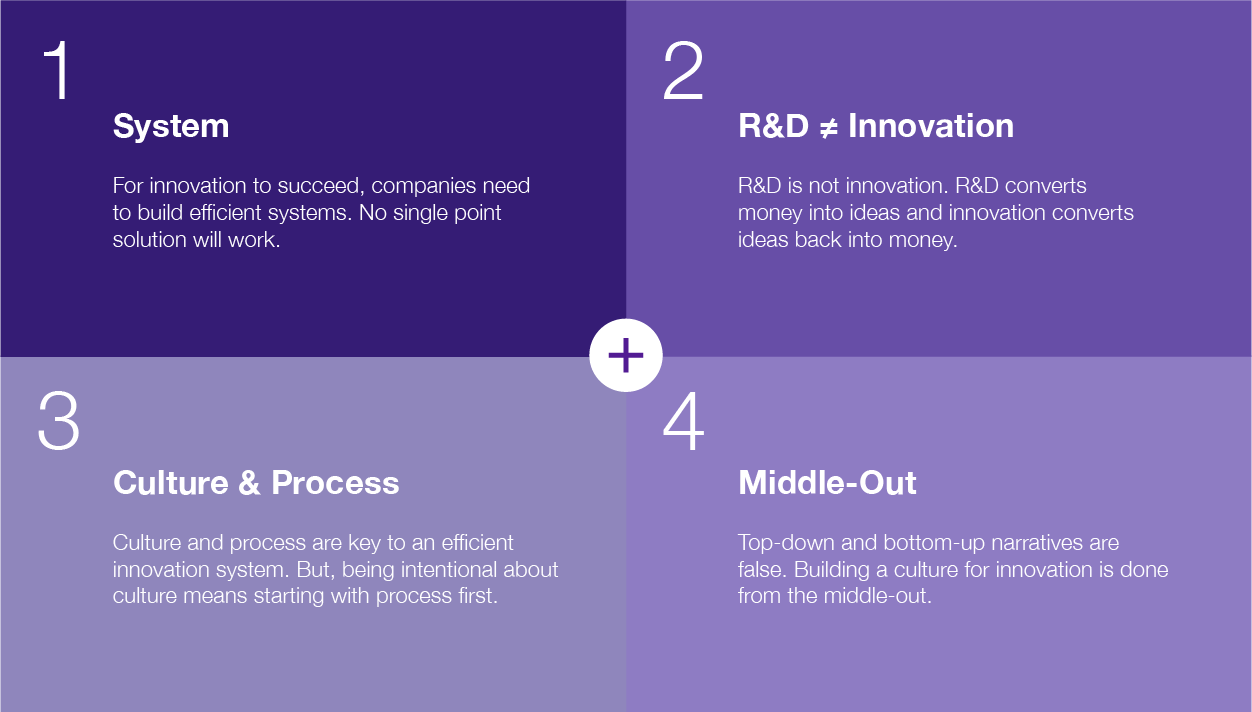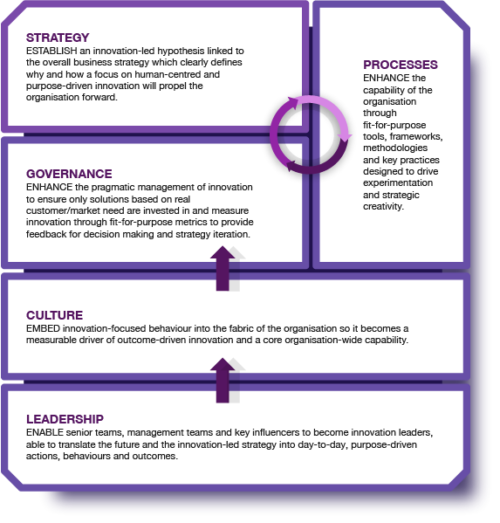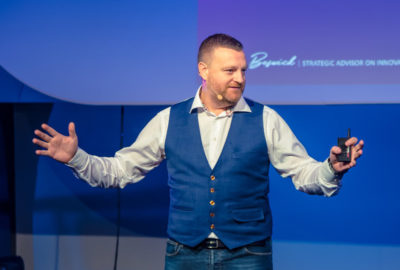Based on our combined experience, we have four core beliefs...
Having worked in multiple industries around the world helping complex organisations shape the future, there are several things that we’ve observed are agnostic when it comes to building a culture of innovation.

We believe innovation is a system game. And that means it’s a team sport!
Any company can drive innovation-led growth, independent of size or industry, as long as it builds the right level of capabilities & culture to allow everyone to contribute to the innovation agenda.
However, the responsibility for creating a return on the innovation investment cannot rest with a single team or be confined to an innovation lab. Shaping the future through innovation requires organisation-wide collaboration, and it’s the job of leaders to build the right environment for that to happen.
At OUTCOME, we help clients consider all aspects of the innovation system and their connection with each other because single elements or ‘point solutions’ don’t fix system problems! From innovation strategy to governance, innovation practice to management and innovation culture & leadership, we help companies make innovation a sustainable and repeatable process and a viable growth engine.
How we help companies build an innovation system
STRATEGY
Developing and deploying an innovation thesis and organisation-wide innovation strategies.
Setting innovation investment goals.
Auditing innovation systems to help unpack what’s holding innovation back across organisations.
GOVERNANCE
Building innovation governance frameworks.
Measuring innovation capability and implementing innovation accounting.
Training managers on how to invest in innovation.

PROCESSES
Innovation process design and implementation.
Innovation team acceleration programs.
HR team innovation development programs.
CULTURE
Innovation culture transformation.
Inspirational keynotes on innovation, strategy, leadership and culture.
LEADERSHIP
Coaching senior executives on how to lead for innovation.
How we work
As the authors of two of the world’s bestselling innovation books, ‘Building a Culture of Innovation’ and ‘The Corporate Startup’, our work is based on a holistic, outcome-driven approach to supercharging leadership and corporate innovation performance to shape the future.
Our dual-operating (micro-fast, macro-slow) methodology means we work with leaders to solve today’s innovation-led growth challenges while building the capabilities for solving the longer-term high-value problems and opportunities shaping the future presents. But most importantly, what we do is an outcome-driven ‘intervention’ designed to do one thing, enable leaders to continue shaping the future when we’re gone.
“At ING we were well know for our pioneering approaches around innovation processes, practices, tools and methodologies. However, what we were conscious of is that this pales in comparison to the importance of leadership decision-making. Fortunately, working with Outcome gave us game-changing insight into how to make data-driven decisions about innovation strategy and culture, enabling us to continuously increase our innovation maturity.”

Lieven Haesaert,
Global Lead Innovation Transformation & Management, ING“The benefits we got from building our innovation strategy with Outcome, were twofold: on one hand we got a very pragmatic and actionable strategy, on the other hand, we were able to engage the organization at large in the process, helping us get the much needed traction needed for the implementation phase.”

Eva McLellan,
General Manager, Roche“The coaching program designed by Outcome delivered two major benefits for our innovation teams. First they learned that innovation needs to happen at speed and second that innovation requires discipline but that it can be done even in a highly regulated healthcare environment.”

Mihai Diga,
Global VP of Health Services, Biotronik“We completely removed the guesswork for our innovation system improvement roadmap by running the innovation audit. We now have an unbiased view of where we are and exactly what we need to do to get to where we want to go.”

Prasatiyo Raharjo,
CEO of Digital Amoeba, Telkom IndonesiaWho we are

CRIS BESWICK
Co-founder
DAN TOMA
Co-founder
YANA YONCHEVA
Business Development
BRUNO PEŠEC
Partner
PETER LEPIANE
Partner
JORGE CASTELLOTE
Partner
MOHAMMAD ALMOMANI
Partner
ANAND BUDHAN
Partner
NIKKI BESWICK
Admin SupportOur books
Our latest thinking

Innovation Accounting is for Everyone
- Posted by Dan Toma
- On 23/04/2024
Innovation accounting can be used by any company regardless of how professional they are with innovation management now. The...

The core principles of Leading FOR Innovation
- Posted by Cris Beswick
- On 28/03/2024
It’s no secret that in today’s dynamic business landscape, for some, innovation is still just a buzzword – but...

Cost of Failure vs. Rate of Failure
- Posted by Dan Toma
- On 21/03/2024
SUMMARY Deciding to focus on the cost of failure instead of the rate of failure will have many positive...
Get in touch
Never before have we had so much opportunity to shape the future. But, what got us here, won’t get us there! So, talk to us about designing a different approach to helping your organisation drive growth and create value through innovation.














